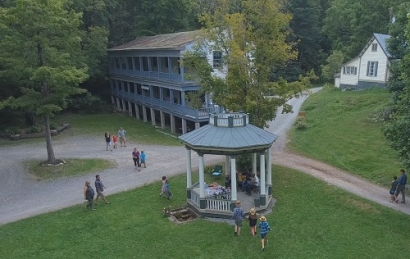
The show itself, called "Penny P's Backyard," is the brainchild of Chris Valluzzo, who works at the university by day and produces documentaries in his spare time. He has been at it for more than a decade.
Valluzzo, who founded Bliss Bus Media to develop the projects, says he wants the show to open up America's Appalachian culture to a national audience the way “Sesame Street” opened up urban culture when it debuted in the 1960s.
In the episodes, Penny and her three friends explore nature, music and American folk art, all while making their own videos and animations in her backyard in the tiny town of Yellow Sulphur Springs, Virginia.
But the production's innovations don't stop with what's seen on the screen. Thanks to a partnership with Solar Connexion, a local solar contractor, the show is believed to be the first television program in history produced using nearly 100 percent renewable energy.
According to the Producer's Guild of America Green Filmmaking template, "if a set uses some minority percentage of their lights as LED vs. traditional energy-sucking Tungten lights, they are achieving a high level of sustainability,” Valluzzo told Renewable Energy Magazine via email.
"In concert with Solar Connexion, we believe we've developed the production plan to attain near 100 percent of our energy use on set coming from solar energy. A massive leapfrog of the industry standard ," he continued.
"We achieve this by using small, yet high-quality, cameras and sound equipment that are rechargeable and utilize 100 percent LED lighting and augmentation of natural available light. We literally have to change the way we shoot to meet this goal," he added.
Solar Connexion’s Cortney Martin told the Roanoke Times newspaper that he was initially skeptical of Valluzzo's proposal to produce a television show entirely with renewables.
"We get quite a few unsolicited, crazy idea emails," Martin told the newspaper. But after meeting with Valluzzo, she said, "We really got excited."
“Sustainability is really a big part of the Appalachian culture. Everything ties back to the sun,” she said. “To be able to use that to provide energy for production just really fits."
He's committed to building sets for the show in such a way that the materials can be donated to Habitat for Humanity and reused to build homes for the homeless.
"Costumes will be sourced from the Goodwill and YMCA and donated back to them for another resale when we're done," Valluzzo said. "Our catering (which will be locally sourced), including plates, forks, and cups will be compostable. Each day our catering refuse will be put into a compost pile and that compost will go to fertilize a community garden that feeds those in need."
"Simply put we are building the effort into the show before the pilot episode is aired," Valluzzo said.
Like all "out of the box big" things, Valluzzo said it took a grassroots efforts to make his dream of an entirely sustainable production a reality.
"Hollywood could be doing this right now if they could just shave a little off their massive profits," he said." We want to force their hand, with a unique and original show, in a unique place, with a community of folks who believe in sustainability, in art, in Science and Technology and Nature. We're actively building those communities now."

